Attached files
| file | filename |
|---|---|
| 8-K - 8-K - REGIONS FINANCIAL CORP | rf-20150515x8xk.htm |

Barclays Americas Select Conference May 20, 2015 Grayson Hall Chairman and CEO Exhibit 99.1

Regions’ aims to be the premier regional financial institution in America through being deeply embedded in its communities, operating as one team with the highest integrity, providing unique and extraordinary service to all of its customers, and offering an unparalleled opportunity for professional growth for its associates. Regions’ Vision Statement 2

3 Key differentiators MARKETS PEOPLE CULTURE CUSTOMER FOCUS

4 Key differentiators MARKETS Birmingham, Alabama Ranked #3 DEPOSIT SHARE IN CORE MARKETS People Culture Customer Focus #2 #1 #5 #1 #2 #4 TOP PROJECTED POPULATION GROWTH TO OUTPACE U.S. AVERAGE HISTORICAL POPULATION GROWTH EXCEEDS ALL OTHER REGIONS OF THE U.S. TOP (1) (2) (3) (1) Core markets include Florida, Alabama, Mississippi, Louisiana, Arkansas, and Tennessee (2) Based on FDIC, US Census Bureau data from 1991-2014 (3) Based on SNL data, projected population growth 2015-2020

5 Key differentiators PEOPLE Markets Culture Customer Focus Recognized by Gallup as one of the top places to work in 2015 Top 40 Recognized by Forbes as one of America’s best employers Top 400

6 Key differentiators CULTURE Customers Shareholders Associates Customer Focus Markets People Shared Value Communities

7 Key differentiators CUSTOMER FOCUS Markets People Culture Regions prescriptive approach to relationship banking ™customers are 2x more profitable than non-360 customers Recognized by Greenwich Associates as a top small business and middle market bank Recognized by Temkin Group for providing industry leading service to consumers ™

Business groups 8 Corporate Banking Group Commercial Banking Specialized Industries Regions Business Capital Real Estate Banking Treasury Management Capital Markets Consumer Retail Consumer Banking Mortgage Credit Card Indirect Auto Lending Regions Now Banking Small Business Banking Wealth Management Investment Services Private Wealth Management Institutional Services Insurance
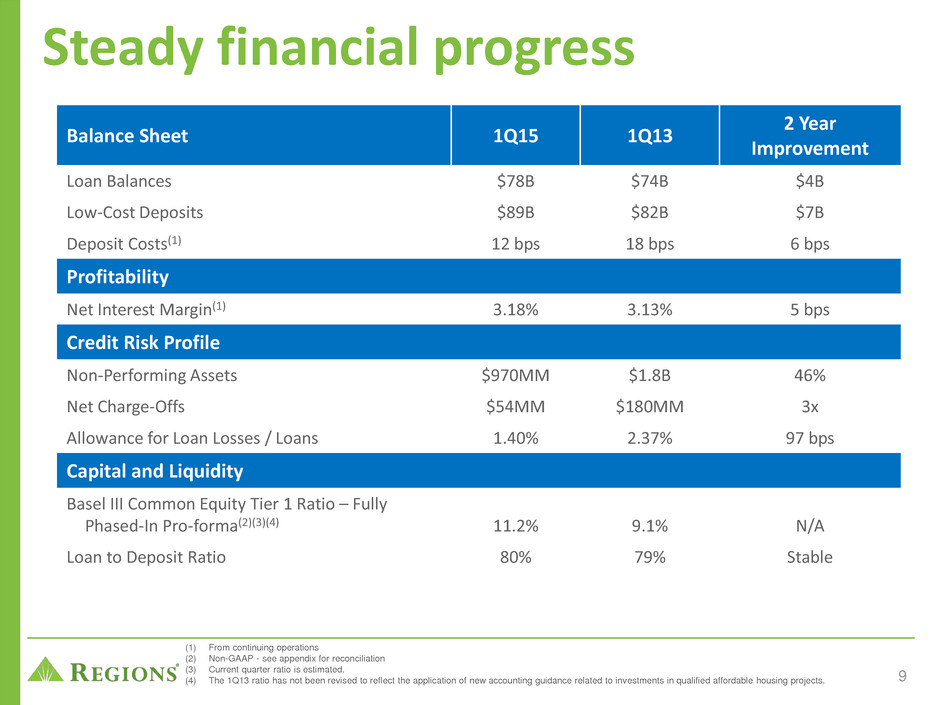
Balance Sheet 1Q15 1Q13 2 Year Improvement Loan Balances $78B $74B $4B Low-Cost Deposits $89B $82B $7B Deposit Costs(1) 12 bps 18 bps 6 bps Profitability Net Interest Margin(1) 3.18% 3.13% 5 bps Credit Risk Profile Non-Performing Assets $970MM $1.8B 46% Net Charge-Offs $54MM $180MM 3x Allowance for Loan Losses / Loans 1.40% 2.37% 97 bps Capital and Liquidity Basel III Common Equity Tier 1 Ratio – Fully Phased-In Pro-forma(2)(3)(4) 11.2% 9.1% N/A Loan to Deposit Ratio 80% 79% Stable Steady financial progress (1) From continuing operations (2) Non-GAAP - see appendix for reconciliation (3) Current quarter ratio is estimated. (4) The 1Q13 ratio has not been revised to reflect the application of new accounting guidance related to investments in qualified affordable housing projects. 9
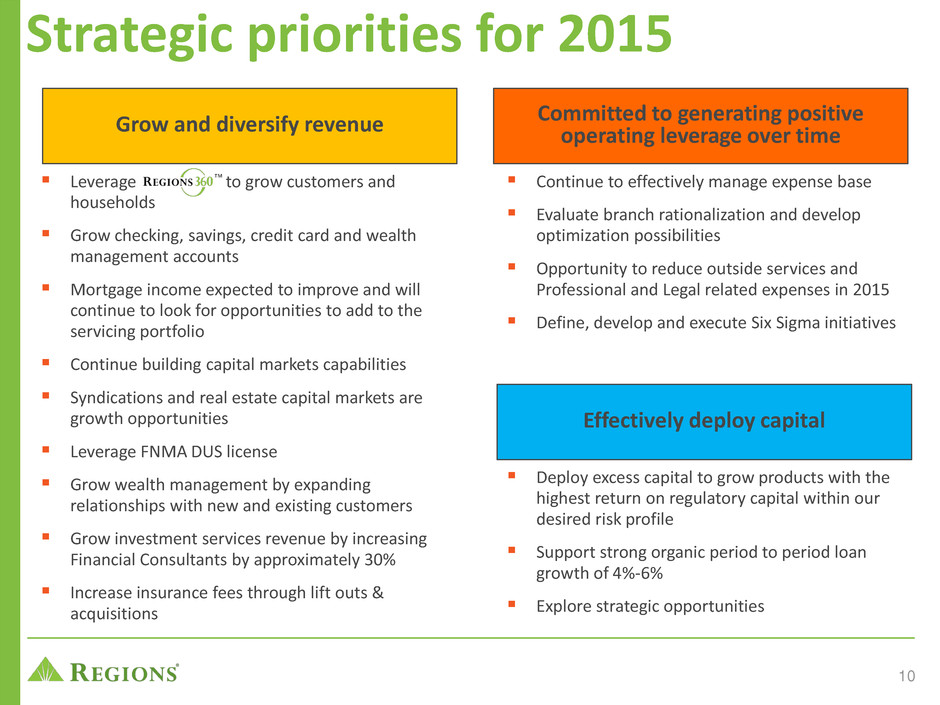
Grow and diversify revenue Committed to generating positive operating leverage over time Effectively deploy capital Leverage ™ to grow customers and households Grow checking, savings, credit card and wealth management accounts Mortgage income expected to improve and will continue to look for opportunities to add to the servicing portfolio Continue building capital markets capabilities Syndications and real estate capital markets are growth opportunities Leverage FNMA DUS license Grow wealth management by expanding relationships with new and existing customers Grow investment services revenue by increasing Financial Consultants by approximately 30% Increase insurance fees through lift outs & acquisitions Continue to effectively manage expense base Evaluate branch rationalization and develop optimization possibilities Opportunity to reduce outside services and Professional and Legal related expenses in 2015 Define, develop and execute Six Sigma initiatives Deploy excess capital to grow products with the highest return on regulatory capital within our desired risk profile Support strong organic period to period loan growth of 4%-6% Explore strategic opportunities Strategic priorities for 2015 10

Grow and diversify revenue 11

Revenue contributors 12 64% 36% Net Interest Income (FTE) Adjusted Non- Interest Income⁽¹⁾ Total Revenue $1.3B Note: Peer banks include BBT, CMA, FHN, FITB, HBAN, KEY, MTB, PNC, STI, USB, WFC, ZION Source: SNL Financial (1) See appendix for reconciliation [VALUE] [VALUE] Net Interest Income (FTE) Adjusted Non- Interest Income Revenue mix – 1Q15 Peer median revenue mix – 1Q15

Net interest margin and loan yields Net interest margin vs. peers 3.26% 3.18% 3.24% 2.93% 1Q14 2Q14 3Q14 4Q14 1Q15 Note: Peer banks include BBT, CMA, FHN, FITB, HBAN, KEY, MTB, PNC, STI, USB, WFC, ZION Source: SNL Financial Loan yield vs. peers 13 4.03% 3.86% 3.92% 3.69% 1Q14 2Q14 3Q14 4Q14 1Q15 Regions Peer Median Significant progress made on net interest margin versus peers Net interest margin has held up well in persistent low rate environment compared to peers 1Q15 net interest margin 25 bps above peer median Loan yields have remained well above peer median Regions continues to maintain a disciplined pricing structure
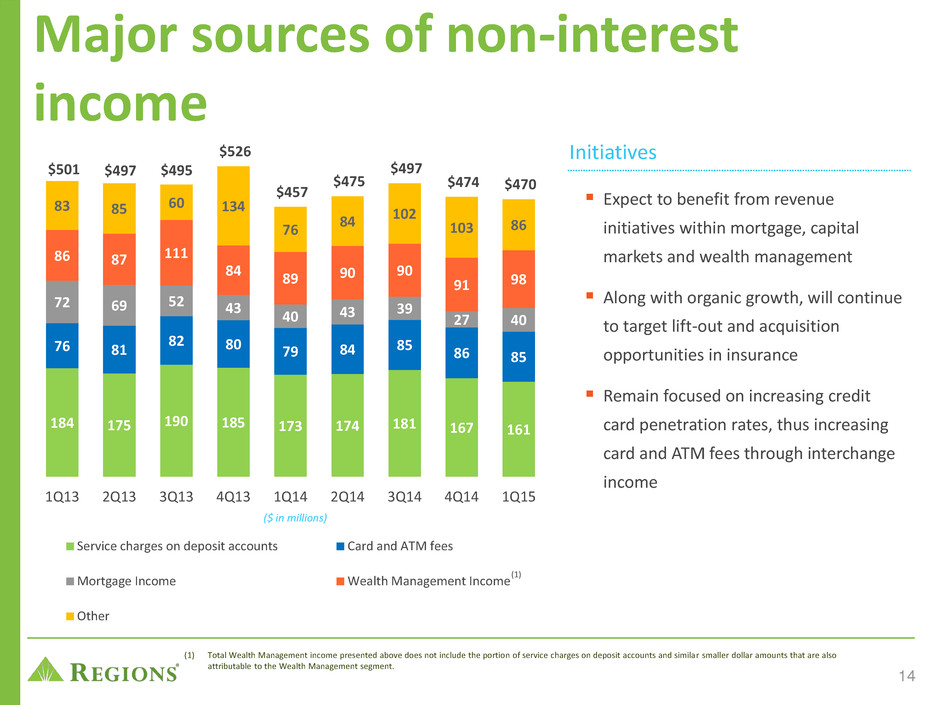
Major sources of non-interest income ($ in millions) (1) Total Wealth Management income presented above does not include the portion of service charges on deposit accounts and similar smaller dollar amounts that are also attributable to the Wealth Management segment. 14 184 175 190 185 173 174 181 167 161 76 81 82 80 79 84 85 86 85 72 69 52 43 40 43 39 27 40 86 87 111 84 89 90 90 91 98 83 85 60 134 76 84 102 103 86 $501 $497 $495 $526 $457 $475 $497 $474 $470 1Q13 2Q13 3Q13 4Q13 1Q14 2Q14 3Q14 4Q14 1Q15 Service charges on deposit accounts Card and ATM fees Mortgage Income Wealth Management Income Other Expect to benefit from revenue initiatives within mortgage, capital markets and wealth management Along with organic growth, will continue to target lift-out and acquisition opportunities in insurance Remain focused on increasing credit card penetration rates, thus increasing card and ATM fees through interchange income Initiatives (1)
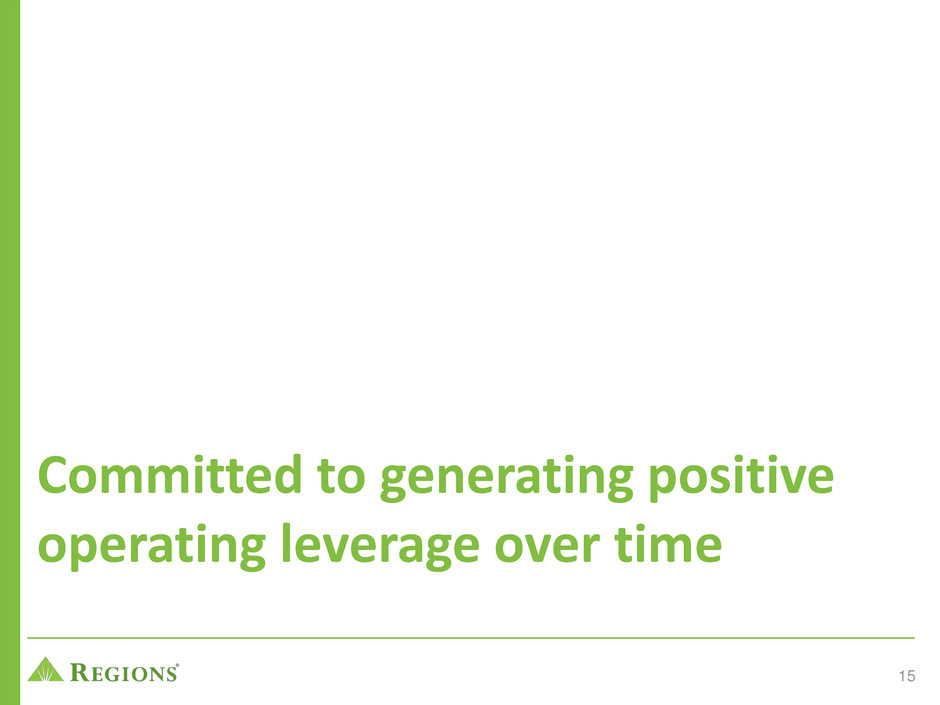
Committed to generating positive operating leverage over time 15
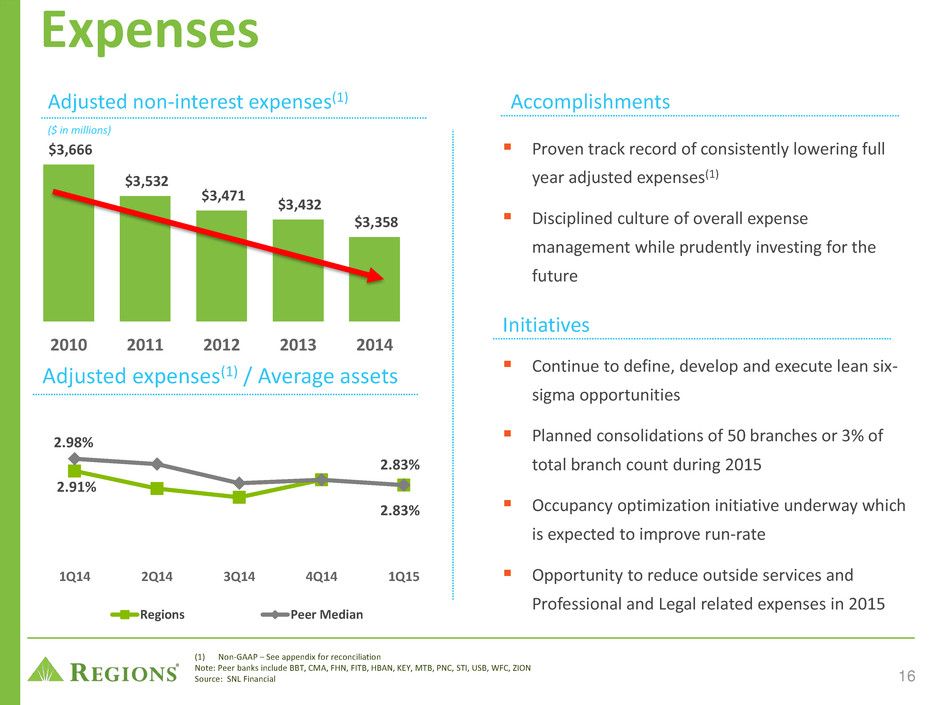
Expenses Adjusted non-interest expenses(1) ($ in millions) $3,666 $3,532 $3,471 $3,432 $3,358 2010 2011 2012 2013 2014 (1) Non-GAAP – See appendix for reconciliation Note: Peer banks include BBT, CMA, FHN, FITB, HBAN, KEY, MTB, PNC, STI, USB, WFC, ZION Source: SNL Financial 16 Adjusted expenses(1) / Average assets Proven track record of consistently lowering full year adjusted expenses(1) Disciplined culture of overall expense management while prudently investing for the future Accomplishments Initiatives Continue to define, develop and execute lean six- sigma opportunities Planned consolidations of 50 branches or 3% of total branch count during 2015 Occupancy optimization initiative underway which is expected to improve run-rate Opportunity to reduce outside services and Professional and Legal related expenses in 2015 2.91% 2.83% 2.98% 2.83% 1Q14 2Q14 3Q14 4Q14 1Q15 Regions Peer Median
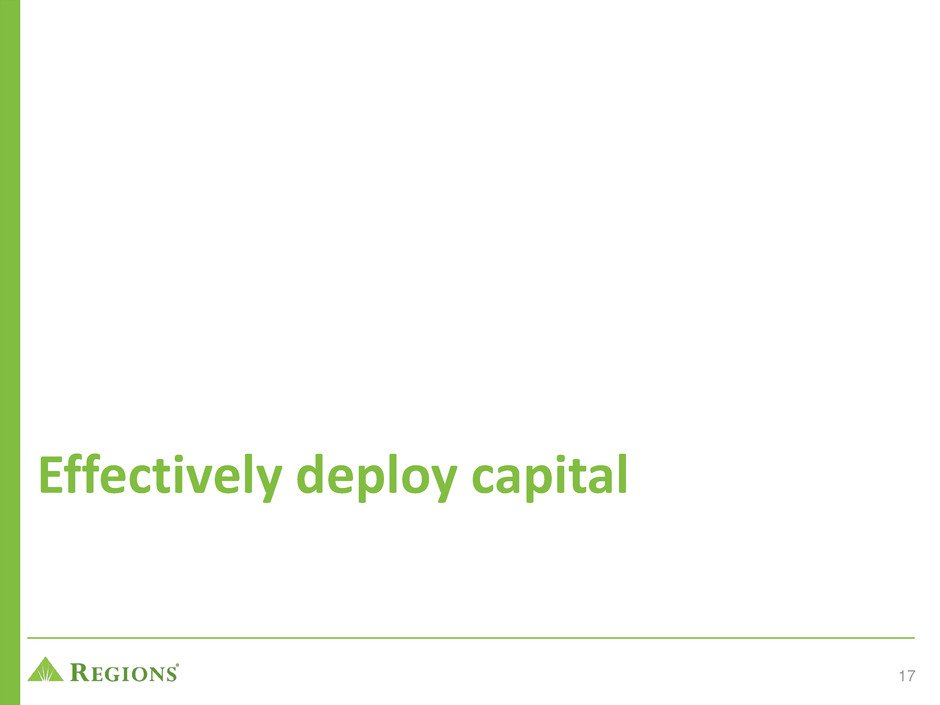
Effectively deploy capital 17

Strong capital position Capital position is sufficient to support both the return of capital and strong organic growth as well as other strategic opportunities Rank 1 Peer #1 11.95% 2 ® 11.41% 3 Peer #3 10.69% 4 Peer #4 10.64% 5 Peer #5 10.50% 6 Peer #6 10.50% 7 Peer #7 10.43% 8 Peer #8 10.31% 9 Peer #9 9.89% 10 Peer #10 9.78% 11 Peer #11 9.60% 12 Peer #12 9.52% 13 Peer #13 9.51% (1) Current quarter Basel III common equity Tier 1 ratios are estimated Note: Peer banks include BBT, CMA, FHN, FITB, HBAN, KEY, MTB, PNC, STI, USB, WFC, ZION Source: SNL Financial 1Q15 Common equity Tier 1(1) 18 Invest and grow Grow loans consistent with risk tolerance Opportunistically evaluate strategic opportunities to include: complementary portfolios including non-banks and banks Return Capital to Shareholders Increase dividends closer to peer average payout levels Share repurchases Capital priorities

Organic growth 19 $73.9 $75.0 $75.9 $74.6 $75.7 $76.5 $76.6 $77.3 $78.2 1Q13 2Q13 3Q13 4Q13 1Q14 2Q14 3Q14 4Q14 1Q15 Business Lending Consumer Lending Ending loan balances ($ in billions) Initiatives Business: Expand specialized lending offerings Grow Real Estate Corporate Banking Lead more syndications Consumer: Expand indirect product offerings through third parties Increase credit card penetration rates Grow direct lending through expanded on-line capabilities Modified first time home buyer programs in mortgage Grow small business lending by increasing the number of SBA loan specialists
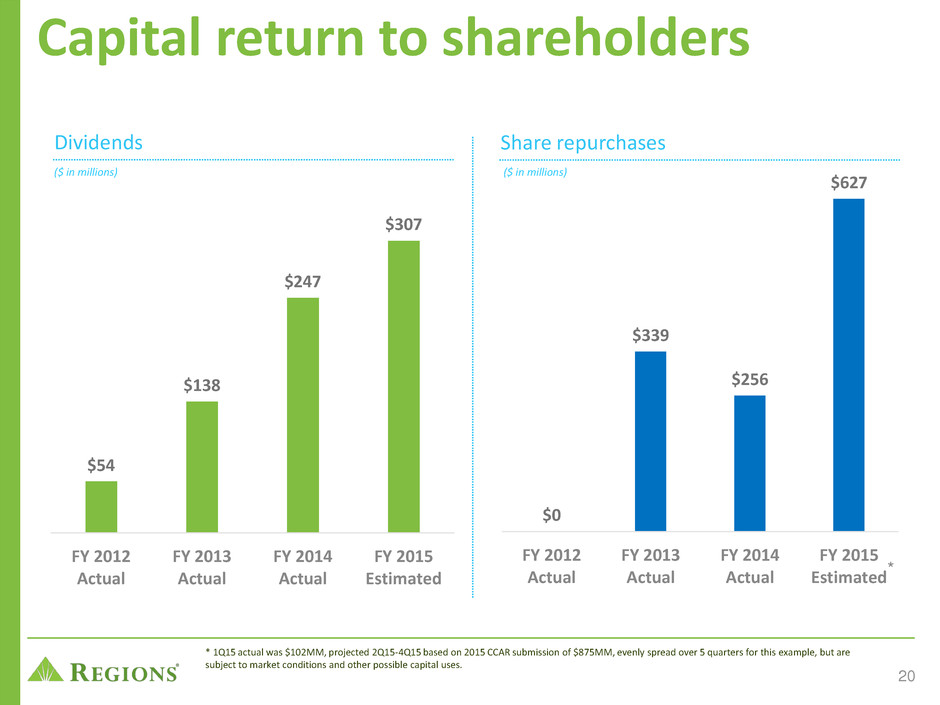
Capital return to shareholders 20 Dividends Share repurchases $0 $339 $256 $627 FY 2012 Actual FY 2013 Actual FY 2014 Actual FY 2015 Estimated* * 1Q15 actual was $102MM, projected 2Q15-4Q15 based on 2015 CCAR submission of $875MM, evenly spread over 5 quarters for this example, but are subject to market conditions and other possible capital uses. ($ in millions) ($ in millions) $54 $138 $247 $307 FY 2012 Actual FY 2013 Actual FY 2014 Actual FY 2015 Estimated

Expectations for 2015 Economic growth expected to pick up over the remainder of the year Continued improvement in housing prices expected Expect an increase in short- term rates in latter part of 2015 21 Economy Loans NIM / Operating leverage Expect total loan growth in the 4% to 6% range on a point-to- point basis Commercial and industrial loans expected to drive growth within business lending portfolio Expect pace of run-off in owner occupied commercial real estate to slow Continued indirect auto lending growth is expected Expect pace of growth in other consumer category to accelerate Credit card growth to continue in near term Expect pace of home equity run- off to moderate Expect to drive net interest income and margin growth over the balance of the year under baseline expectations for loan growth and increase in interest rates late in the year Committed to generating positive operating leverage over time Deposits Expect full year average balance growth of 1% to 2%
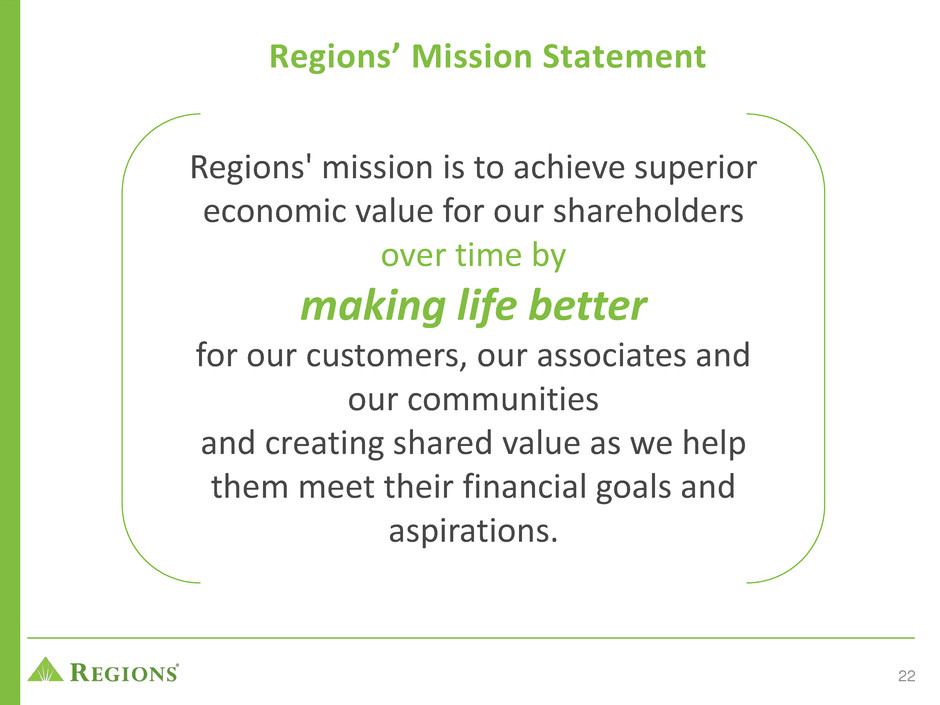
22 Regions' mission is to achieve superior economic value for our shareholders over time by making life better for our customers, our associates and our communities and creating shared value as we help them meet their financial goals and aspirations. Regions’ Mission Statement

23 Appendix

24 Non-GAAP reconciliation: Non- interest income/expense NM – Not Meaningful (1) Regions recorded $100 million of contingent legal and regulatory accruals during the fourth quarter of 2014 related to previously disclosed matters. (2) Regions recorded a non-tax deductible regulatory charge of $58 million during the fourth quarter of 2013 related to previously disclosed inquiries from government authorities. These matters were settled in the second quarter of 2014 for $7 million less than originally estimated and a corresponding recovery was recognized. The table below presents non-interest expense (GAAP) excluding certain adjustments to arrive at adjusted non-interest expense (non-GAAP). Non-interest income (GAAP) is presented excluding certain adjustments to arrive at adjusted non-interest income (non-GAAP). Regions believes that the exclusion of these adjustments provides a meaningful base for period-to-period comparisons, which management believes will assist investors in analyzing the operating results of the Company and predicting future performance. These non-GAAP financial measures are also used by management to assess the performance of Regions’ business. It is possible that the activities related to the adjustments may recur; however, management does not consider the activities related to the adjustments to be indications of ongoing operations. Regions believes that presentation of these non-GAAP financial measures will permit investors to assess the performance of the Company on the same basis as that applied by management. Quarter Ended ($ amounts in millions) 3/31/2015 12/31/2014 9/30/2014 6/30/2014 3/31/2014 1Q15 vs. 4Q14 1Q15 vs. 1Q14 ADJUSTED NON-INTEREST INCOME/EXPENSE- CONTINUING OPERATIONS Non-interest expense (GAAP) $ 905 $ 969 $ 826 $ 820 $ 817 $ (64 ) (6.6 )% $ 88 10.8 % Adjustments: Professional, legal and regulatory expenses(1)(2) — (100 ) — 7 — 100 (100.0 )% — NM Branch consolidation and property and equipment charges (22 ) (10 ) — — (6 ) (12 ) 120.0 % (16 ) 266.7 % Loss on early extinguishment of debt (43 ) — — — — (43 ) NM (43 ) NM Gain on sale of TDRs held for sale, net — — — — 35 — NM (35 ) (100.0 )% Adjusted non-interest expense (non-GAAP) $ 840 $ 859 $ 826 $ 827 $ 846 $ (19 ) (2.2 )% $ (6 ) (0.7 )% Net interest income (GAAP) $ 815 $ 820 $ 821 $ 823 $ 816 $ (5 ) (0.6 )% $ (1 ) (0.1 )% Taxable-equivalent adjustment 17 17 16 15 15 — NM 2 13.3 % Net interest income, taxable-equivalent basis $ 832 $ 837 $ 837 $ 838 $ 831 $ (5 ) (0.6 )% $ 1 0.1 % Non-interest income (GAAP) $ 470 $ 474 $ 497 $ 475 $ 457 $ (4 ) (0.8 )% $ 13 2.8 % Adjustments: Securities gains, net (5 ) (12 ) (7 ) (6 ) (2 ) 7 (58.3 )% (3 ) 150.0 % Leveraged lease termination gains, net (2 ) — (9 ) — (1 ) (2 ) NM (1 ) 100.0 % Adjusted non-interest income (non-GAAP) $ 463 $ 462 $ 481 $ 469 $ 454 $ 1 0.2 % $ 9 2.0 %

Non-GAAP reconciliation: Basel III common equity Tier 1 ratio – fully phased-in pro-forma The calculation of the fully phased-in pro-forma "Common equity Tier 1" (CET1) is based on Regions’ understanding of the Final Basel III requirements. For Regions, the Basel III framework became effective on a phased- in approach starting in 2015 with full implementation beginning in 2019. The calculation provided below includes estimated pro-forma amounts for the ratio on a fully phased-in basis. Regions’ current understanding of the final framework includes certain assumptions, including the Company’s interpretation of the requirements, and informal feedback received through the regulatory process. Regions’ understanding of the framework is evolving and will likely change as analysis and discussions with regulators continue. Because Regions is not currently subject to the fully-phased in capital rules, this pro-forma measure is considered to be a non-GAAP financial measure, and other entities may calculate it differently from Regions’ disclosed calculation. A company's regulatory capital is often expressed as a percentage of risk-weighted assets. Under the risk-based capital framework, a company’s balance sheet assets and credit equivalent amounts of off-balance sheet items are assigned to broad risk categories. The aggregated dollar amount in each category is then multiplied by the prescribed risk-weighted percentage. The resulting weighted values from each of the categories are added together and this sum is the risk-weighted assets total that, as adjusted, comprises the denominator of certain risk-based capital ratios. Common equity Tier 1 capital is then divided by this denominator (risk- weighted assets) to determine the common equity Tier 1 capital ratio. The amounts disclosed as risk-weighted assets are calculated consistent with banking regulatory requirements on a fully phased-in basis. Since analysts and banking regulators may assess Regions’ capital adequacy using the fully phased-in Basel III framework, we believe that it is useful to provide investors the ability to assess Regions’ capital adequacy on this same basis. (1) Current quarter amount and the resulting ratio are estimated. Basel III Common Equity Tier 1 ratio-Fully Phased-In Pro-Forma for periods prior to the first quarter of 2015 were not revised to reflect the retrospective application of new accounting guidance related to investments in qualified affordable housing projects. As a result, those calculations have been removed from the table. (2) Regions continues to develop systems and internal controls to precisely calculate risk-weighted assets as required by Basel III on a fully phased-in basis. The amount included above is a reasonable approximation, based on our understanding of the requirements. 25 ($ amounts in millions) 3/31/2015 Basel III Common Equity Tier 1 Ratio—Fully Phased-In Pro-Forma(1) Stockholder's equity (GAAP) $ 17,051 Non-qualifying goodwill and intangibles (4,910 ) Adjustments, including all components of accumulated other comprehensive income, disallowed deferred tax assets, threshold deductions and other adjustments 1 Preferred stock (GAAP) (868 ) Basel III common equity Tier 1 (non-GAAP) A $ 11,274 Basel III risk-weighted assets (non-GAAP)(2) B $ 101,027 Basel III common equity Tier 1 ratio (non-GAAP) A/B 11.2 %

Forward-looking statements The foregoing list of factors is not exhaustive. For discussion of these and other factors that may cause actual results to differ from expectations, look under the captions “Forward-Looking Statements” and “Risk Factors" of Regions' Annual Report on Form 10-K for the year ended December 31, 2014, as filed with the Securities and Exchange Commission. The words “anticipates,” “intends,” “plans,” “seeks,” “believes,” “estimates,” “expects,” “targets,” “projects,” “outlook,” “forecast,” “will,” “may,” “could,” “should,” “can,” and similar expressions often signify forward- looking statements. You should not place undue reliance on any forward-looking statements, which speak only as of the date made. We assume no obligation to update or revise any forward-looking statements that are made from time to time. This presentation may include forward-looking statements, as defined in the Private Securities Litigation Reform Act of 1995, which reflect Regions’ current views with respect to future events and financial performance. Forward-looking statements are not based on historical information, but rather are related to future operations, strategies, financial results or other developments. Forward-looking statements are based on management’s expectations as well as certain assumptions and estimates made by, and information available to, management at the time the statements are made. Those statements are based on general assumptions and are subject to various risks, uncertainties and other factors that may cause actual results to differ materially from the views, beliefs and projections expressed in such statements. These risks, uncertainties and other factors include, but are not limited to, those described below: 26 • Current and future economic and market conditions in the United States generally or in the communities we serve, including the effects of declines in property values, unemployment rates and potential reductions of economic growth, which may adversely affect our lending and other businesses and our financial results and conditions. • Possible changes in trade, monetary and fiscal policies of, and other activities undertaken by, governments, agencies, central banks and similar organizations, which could have a material adverse effect on our earnings. • The effects of a possible downgrade in the U.S. government’s sovereign credit rating or outlook, which could result in risks to us and general economic conditions that we are not able to predict. • Possible changes in market interest rates or capital markets could adversely affect our revenue and expense, the value of assets and obligations, and the availability and cost of capital and liquidity. • Any impairment of our goodwill or other intangibles, or any adjustment of valuation allowances on our deferred tax assets due to adverse changes in the economic environment, declining operations of the reporting unit, or other factors. • Possible changes in the creditworthiness of customers and the possible impairment of the collectability of loans. • Changes in the speed of loan prepayments, loan origination and sale volumes, charge-offs, loan loss provisions or actual loan losses where our allowance for loan losses may not be adequate to cover our eventual losses. • Possible acceleration of prepayments on mortgage-backed securities due to low interest rates, and the related acceleration of premium amortization on those securities. • Our ability to effectively compete with other financial services companies, some of whom possess greater financial resources than we do and are subject to different regulatory standards than we are. • Loss of customer checking and savings account deposits as customers pursue other, higher-yield investments, which could increase our funding costs. • Our inability to develop and gain acceptance from current and prospective customers for new products and services in a timely manner could have a negative impact on our revenue. • Changes in laws and regulations affecting our businesses, such as the Dodd-Frank Act and other legislation and regulations relating to bank products and services, as well as changes in the enforcement and interpretation of such laws and regulations by applicable governmental and self-regulatory agencies, which could require us to change certain business practices, increase compliance risk, reduce our revenue, impose additional costs on us, or otherwise negatively affect our businesses. • Our ability to obtain no regulatory objection (as part of the comprehensive capital analysis and review ("CCAR") process or otherwise) to take certain capital actions, including paying dividends and any plans to increase common stock dividends, repurchase common stock under current or future programs, or redeem preferred stock or other regulatory capital instruments, may impact our ability to return capital to stockholders and market perceptions of us. • Our ability to comply with applicable capital and liquidity requirements (including the finalized Basel III capital standards), including our ability to generate capital internally or raise capital on favorable terms, and if we fail to meet requirements, our financial condition could be negatively impacted. • The costs, including possibly incurring fines, penalties, or other negative effects (including reputational harm) of any adverse judicial, administrative, or arbitral rulings or proceedings, regulatory enforcement actions, or other legal actions to which we or any of our subsidiaries are a party, and which may adversely affect our results. • Our ability to manage fluctuations in the value of assets and liabilities and off-balance sheet exposure so as to maintain sufficient capital and liquidity to support our business. • Possible changes in consumer and business spending and saving habits and the related effect on our ability to increase assets and to attract deposits, which could adversely affect our net income. • Any inaccurate or incomplete information provided to us by our customers or counterparties. • Inability of our framework to manage risks associated with our business such as credit risk and operational risk, including third-party vendors and other service providers, which could, among other things, result in a breach of operating or security systems as a result of a cyber attack or similar act. • The inability of our internal disclosure controls and procedures to prevent, detect or mitigate any material errors or fraudulent acts. • The effects of geopolitical instability, including wars, conflicts and terrorist attacks and the potential impact, directly or indirectly on our businesses. • The effects of man-made and natural disasters, including fires, floods, droughts, tornadoes, hurricanes, and environmental damage, which may negatively affect our operations and/or our loan portfolios and increase our cost of conducting business. • Our inability to keep pace with technological changes could result in losing business to competitors. • Our ability to identify and address cyber-security risks such as data security breaches, "denial of service" attacks, "hacking" and identity theft, a failure of which could disrupt our business and result in the disclosure of and/or misuse or misappropriation of confidential or proprietary information; increased costs; losses; or adverse effects to our reputation. • Possible downgrades in our credit ratings or outlook could increase the costs of funding from capital markets. • The effects of problems encountered by other financial institutions that adversely affect us or the banking industry generally could require us to change certain business practices, reduce our revenue, impose additional costs on us, or otherwise negatively affect our businesses. • The effects of the failure of any component of our business infrastructure provided by a third party could disrupt our businesses; result in the disclosure of and/or misuse of confidential information or proprietary information; increase our costs; negatively affect our reputation; and cause losses. • Our ability to receive dividends from our subsidiaries could affect our liquidity and ability to pay dividends to stockholders. • Changes in accounting policies or procedures as may be required by the Financial Accounting Standards Board or other regulatory agencies could materially affect how we report our financial results. • The effects of any damage to our reputation resulting from developments related to any of the items identified above.

27
